Driving on a Budget
By Nikki Alvin-Smith
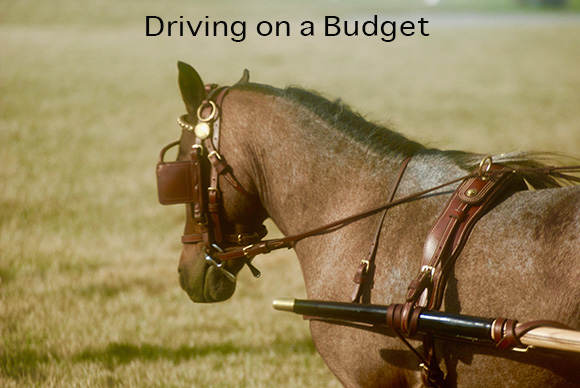
For many horse lovers the idea of venturing into the world of carriage driving is intimidating, largely due to the image of the discipline as one of sincere expense. If you are one of those folks that have contemplated trotting down the lane of driving, there are lots of ways you can get started on a budget. Why not realize your dream view of your horse’s swinging back with two alert ears in front, reins in your hands and your well-projected voice in charge of affairs? What a super way to travel.
Whatever has driven you to drive horses, here are a few suggestions to help ensure you enjoy a successful and affordable introduction into the art of driving. It is best to cut costs, but not corners!
Beg, Borrow and Steal A Deal
You’ll obviously need a reliable ‘engine’ to pull the horse drawn carriage. It is always prudent to ‘put the horse before the cart’ as the size of the horse will determine the size of the carriage and the harness. Otherwise you may end up with equipment that won’t fit properly and cause all sorts of issues down the road.
The horse you select may be untrained or trained to the harness. If you are starting out it is best if you can select a horse that has already been properly trained to drive, as this will help you learn at a quicker pace. While this is ideal, it is not necessary if you are already an experienced horse person and can take on the ground training.
Regardless of which route you choose, it is sensible to take some instruction from a carriage driving professional. Expert advice should also be sought when it comes to the horse drawn vehicle you select and the harness you choose to connect the two.
Free advice can be invaluable, but needs to be carefully resourced. While social media can offer lots of ideas, the validated material and know-how from a proven carriage driving source such as a book or DVD produced by a trusted publishing house or prestige magazine that is driving discipline specific, is a great place to start. Once you have done your due diligence and have some idea of what is what in the art of driving you can also visit driving events at local driving clubs and harness the expertise of their members. Don’t be shy to ask questions and generally educate yourself as much as possible throughout the process. As horse owners, we all love nothing better than talking about our horses and sharing advice.
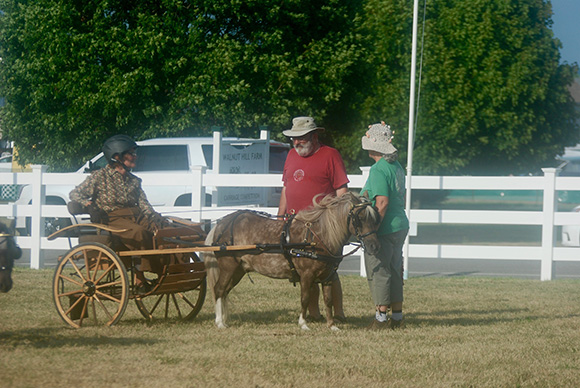
If you are currently a professional in another equestrian discipline, you may be able to exchange your knowledge in your riding sport with an expert in carriage driving. The barter system can be extremely lucrative on both sides. For example, if you are a dressage trainer and know lots about collection, rein backs and bit connection, you may be able to work together with an aficionado of the driving genre, to bring out the best in their horses for the dressage driving arena. Similarly, you may be able to offer grooming services, vet tech experience or simply a volunteer to act as groom and learn the ropes of the back seat in exchange for concrete experience and instruction. You can ‘steal a deal’ this way, without paying any upfront cash to see if this discipline is something you want to invest further dollars and time to do. It is always wise not to overinvest at the beginning. See if you like it first! And see that firsthand.
Not all horses that make great riding horses make good driving horses or vice versa. When driving you have more limited communication than you enjoy in the saddle, as you are sitting ten feet from your horse’s head and have no seat or leg aids to employ.
Many folks utilize their child’s outgrown pony as an initial driving partner. This can work out well as ponies are often accustomed to all kinds of activities and can transition happily into harness. If you don’t have a pony in your stable yard, you can often save money by accessing one from a friend or colleague who may be pleased to see their pony put to work and given a job. Beg and borrow can be a great first step. This applies to everything from horse to harness and cart or carriage.
A good driving horse can be expensive and hard to find. Resist the temptation to seek out an individual from an auction where the animal is untested, or from homes where the horse is said to have previous experience in harness, with no proof of such an achievement being demonstrated. It is a false economy to buy the wrong horse. It can result in a carriage crash, broken tack, and injury to both yourself and the horse in question.
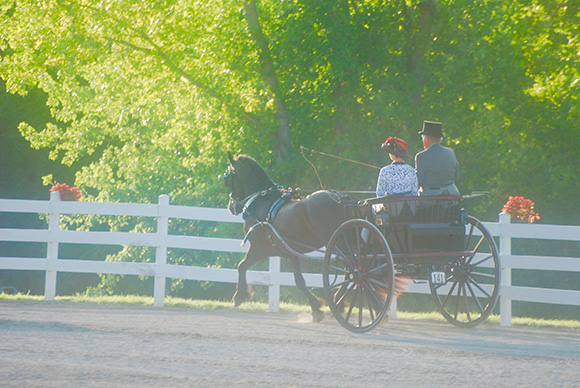
If you are a neophyte to driving it is smart to stay with horse breeds that are known to exhibit good temperaments and conformation for driving such as Haflingers, Norwegian Fjords or pony breeds such as the Welsh pony. Once you become more advanced in the art of driving, you can take advantage of the true harness horse the Hackney, the flashy Friesian or the masterful Morgan.
Whatever horse you find, the first time you harness it and most certainly the first time you take it out, you should always work with a driving expert. Regardless of the horse’s experience, attention to correct tack fit, carriage fit and evaluation of the chosen equine’s work ethic, training and temperament needs to be done by a professional to keep both you and other road users safe. Your budget should allow for the help of a trainer, especially in the early stages of your relationship with a new horse or a horse you are training to harness from scratch.
Do Your Homework
You may know much about pre-purchase exams and horse selection and care, but may know nothing about the purchase of the horse drawn vehicle or how to marry the horse and carriage together.
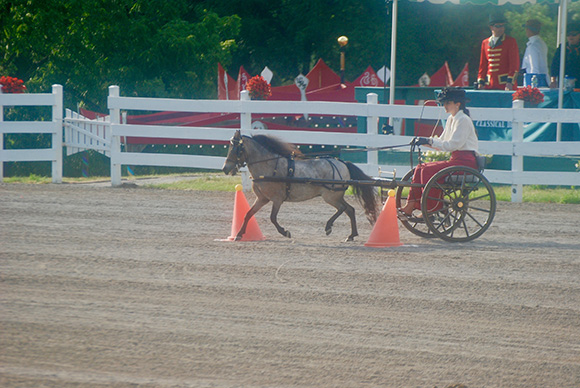
Carriages are available for purchase from private sellers to large auctions as well as at major driving events. The advent of the internet, has made the ability to hook up buyer and seller easier than ever before. You might be surprised to learn that finding the right carriage can be difficult nonetheless.
Unlike the auto industry where certain safety standards are in place, the carriage industry is held to no such requirements. You are responsible for the safety of the vehicle when used on the roads, so a full inspection of the prospective purchase is essential. It is false economy to buy something poorly made, designed or maintained. Aside from the safety of the carriage, the fit for your horse or pony and yourself as whip must also be considered.
For budget reasons a two-wheeled carriage is probably best for the novice whip. The added advantages of being simpler to handle and the fact it cannot jackknife make it a good contender as a first vehicle, even if it is not as comfortable for the whip and passenger as a four-wheel design. Solid tires are popular as they last seemingly forever, and have the benefit that they cannot puncture or even worse suffer a blow out, the noise from which can cause a horse to panic. Whatever tire you choose, the two-wheel carriage must be in balance. Otherwise the horse will suffer the full weight of the vehicle on the shafts going downhill and the rip of the carriage as it tips up when navigating an incline.
Your best investment is to find a model that can be adjusted to fit a variety of horse sizes with the balance easy to adjust with the turn of a winding mechanism. This means you can properly fit the carriage to a variety of horses and provides better resale opportunities later.
Size wise it is imperative that the vehicle has sufficient leg room for the horse and the whip. There must be enough to allow the whip’s legs to slope down without a great bend in the knee. This is a matter of comfort and safety too. A whip may need to use a pulling action on the reins if the horse panics, and this is not easy to do without leverage of the legs braced against the floor. If your leg is shorter, (a problem I experience as a Grand Prix dressage competitor riding large horses, so I can relate), and cannot comfortably reach the floor of the vehicle, don’t be put off a perfectly wonderful looking cart or carriage and turn away a good deal. The simple addition of a well-secured footrest at the proper angle can make the carriage perfectly useful. Such inexpensive fixes can open up a larger market to you as the buyer, and provide more choices budget wise in vehicle selection.
Ideally a used exercise carriage is perfect for the neophyte driver, as it can handle minor damage and requires less upkeep than a fancier carriage.
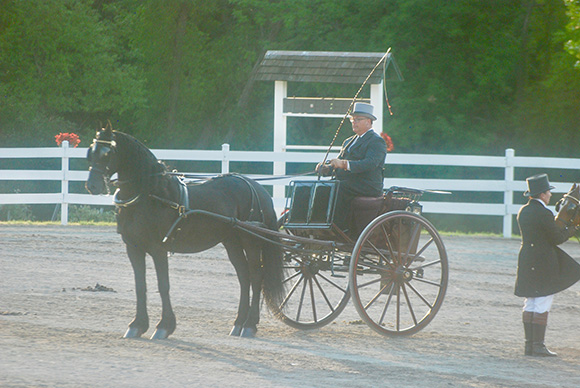
A good money saving tip is to take all the necessary sizing measurements before you set off to purchase a vehicle. This can save you a great deal of headaches when it comes to fit and avoid an expensive mistake.
Obviously the ideal solution would be to ‘put’ the horse to the carriage and try it out firsthand for fit for both horse and whip but this is not always an option. Once again the help of an expert is invaluable in this regard. Not only will they likely have a vehicle you can test fit, but they can aid you in taking the varietal measurements you need. And who knows, perhaps during this process you can beg, borrow and steal a deal, to use what the trainer has on hand equipment wise, on a temporary basis.
You also need to do your homework in regard to the harness and buy just what you need with a prudent eye to the future.
There are an abundance of used harnesses available on the market at auctions, tack swaps and driving events. Amish horse auctions and sales yards often have a large supply of horse harness equipment that is either used or brand new.
Used tack will often be made of leather and have seen some wear. The upkeep of leather is critical to its wear and tear, and so any used tack should be carefully examined especially if it shows signs of cracking or prior repairs. Newer, easy clean materials such as nylon and synthetic can be less expensive to purchase. The disadvantage is that while you might be able to throw the entire kit in a bag in the washing machine to clean, these materials won’t break in times of emergency. Bear in mind, all harnesses require cleaning.
It used to be that synthetic harnesses were significantly cheaper than their leather counterparts but they were considered of inferior quality. Today, the price difference has evened up as the cost of raw materials such as PVC and polyurethane products, utilized to make synthetic tack have risen, driven by oil prices. The quality of the synthetic harness has also greatly improved in recent years. Although it will not conform as nicely to the horse’s physique as a leather harness will over time, it is lighter to use and much less time-consuming to clean.
If you know your end goal in driving you can save money by making the best decision for your future needs now rather than having to switch up tack later. If you dream of competing in a marathon and showing in general, a high level of fitness will be required and you will work in all weathers and environments, so a synthetic harness might be the way to go. On the other hand if you plan to enjoy a pleasure drive on a sunny day, you might prefer the weight and feel of a leather rein and a harness that contours to your horse over time.
For the beginner whip a breast collar harness is not only easier to use than a full collar, it is also cheaper to buy. It has the additional benefit of being kinder for training purposes for a horse new to driving and provides good adjustability for fit.
Don’t Take a Blinkered Approach
In conclusion whatever horse and carriage, tack and equipment you choose, investment in safety should always come first. Harnesses and carriages hold their value well, and the better quality you buy now the better resale value it will have down the road. As long as you take care of it!
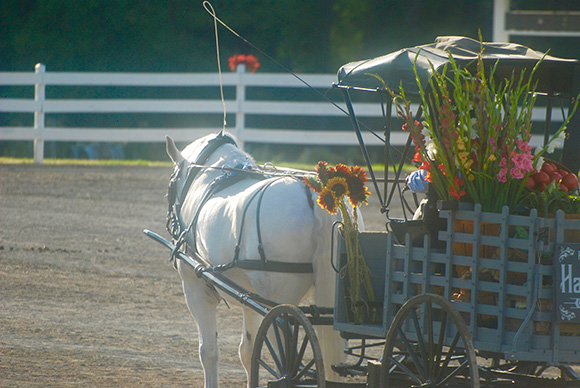
The money you put into expert advice will ultimately also save you from making costly mistakes and ensure that a minor issue in your horse training does not become a major crisis and that the tack and equipment you purchase will do the job you need it to accomplish. When you add the ability to be safely driven to your horse’s resume, it will also increase its appraised value.
Many horse owners find themselves unable to sit in the saddle for various reasons after a lifetime passion for riding, and turn to driving as an alternative way to still enjoy their enthusiasm for all things equine. Driving is a more accessible than first glance might suggest. Take up those reins and give it a go!
About the author: Nikki Alvin-Smith is a professional freelance writer and content creator, who works with a variety of publications and manufacturers worldwide. She is a British international Grand Prix dressage trainer/clinician who has competed in Europe at the Grand Prix level earning scores of over 72%. Together with her husband Paul, who is also a Grand Prix rider, they operate Willowview Hill Farm, a private horse breeding/training farm in Stamford, NY. Please visit her website at https:/www.nikkialvinsmithstudio.com to learn more.


